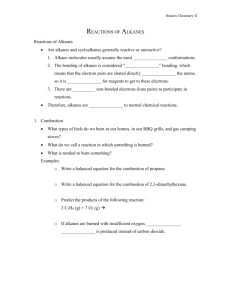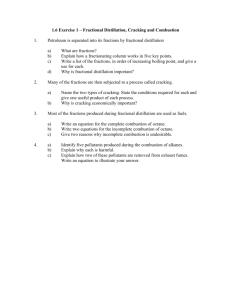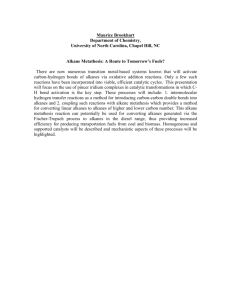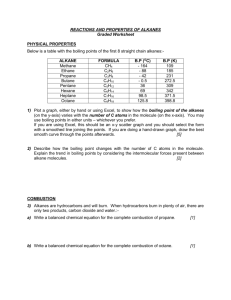Alkanes
advertisement
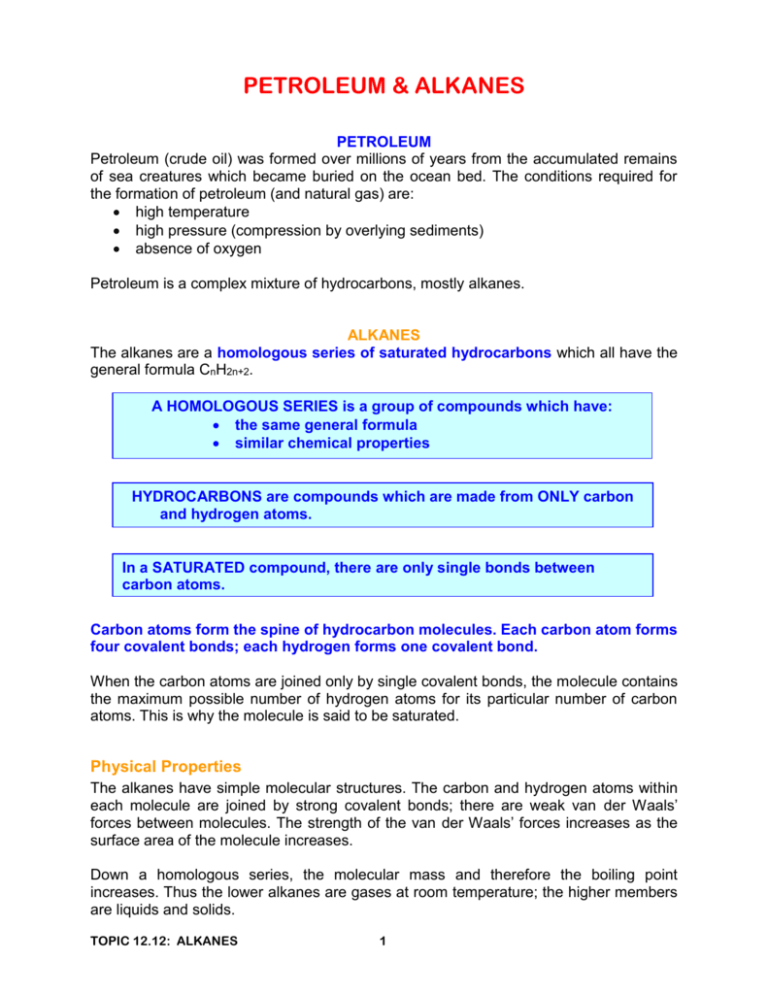
PETROLEUM & ALKANES PETROLEUM Petroleum (crude oil) was formed over millions of years from the accumulated remains of sea creatures which became buried on the ocean bed. The conditions required for the formation of petroleum (and natural gas) are: high temperature high pressure (compression by overlying sediments) absence of oxygen Petroleum is a complex mixture of hydrocarbons, mostly alkanes. ALKANES The alkanes are a homologous series of saturated hydrocarbons which all have the general formula CnH2n+2. A HOMOLOGOUS SERIES is a group of compounds which have: the same general formula similar chemical properties HYDROCARBONS are compounds which are made from ONLY carbon and hydrogen atoms. In a SATURATED compound, there are only single bonds between carbon atoms. Carbon atoms form the spine of hydrocarbon molecules. Each carbon atom forms four covalent bonds; each hydrogen forms one covalent bond. When the carbon atoms are joined only by single covalent bonds, the molecule contains the maximum possible number of hydrogen atoms for its particular number of carbon atoms. This is why the molecule is said to be saturated. Physical Properties The alkanes have simple molecular structures. The carbon and hydrogen atoms within each molecule are joined by strong covalent bonds; there are weak van der Waals’ forces between molecules. The strength of the van der Waals’ forces increases as the surface area of the molecule increases. Down a homologous series, the molecular mass and therefore the boiling point increases. Thus the lower alkanes are gases at room temperature; the higher members are liquids and solids. TOPIC 12.12: ALKANES 1 Straight chain alkanes Name methane ethane propane butane pentane hexane heptane octane nonane decane undecane dodecane tridecane tetradecane pentadecane hexadecane heptadecane octadecane nonadecane eicosane Formula CH4 C2H6 C3H8 C4H10 C5H12 C6H14 C7H16 C8H18 C9H20 C10H22 C11H24 C12H26 C13H28 C14H30 C15H32 C16H34 C17H36 C18H38 C19H40 C20H42 m.p. /oC b.p. /oC -182 -162 -183 -89 -188 -42 -138 -0.5 -130 36 -95 69 -91 98 -57 126 -54 151 -30 174 -26 196 -10 216 -5.5 235 6 254 10 271 18 287 22 302 28 316 32 330 37 343 Density /g.cm-3 0.626 0.659 0.684 0.703 0.718 0.730 0.740 0.749 0.756 0.763 0.769 0.773 0.778 0.782 0.786 0.789 Isomeric alkanes Isomers have different boiling points because these depend on the strength of the intermolecular forces. The strength of the intermolecular forces, and therefore the boiling point, decreases as the amount of chain branching increases. Straight chain alkanes are approximately sausage shaped, but as the amount of branching increases, the shape becomes more spherical. This can be seen in the diagrams below: pentane b.p. 36oC 2-methylbutane b.p. 28oC 2,2-dimethylpropane b.p. 10oC The more spherical the structure, the smaller the surface area is and so the weaker the van der Waals’ forces are. Therefore the boiling point decreases. Chemical Properties Alkanes contain only C-C and C-H bonds, which are strong and non-polar. Alkanes are, therefore, unreactive towards acids, alkalis, electrophiles and nucleophiles. They do, however, readily undergo combustion and are important as fuels. TOPIC 12.12: ALKANES 2 FRACTIONAL DISTILLATION The properties of each substance in a mixture are unchanged. This makes it possible to separate substances in a mixture by physical methods including distillation. The complex mixture of hydrocarbons in crude oil can be separated into simpler mixtures or fractions by fractional distillation. Fractions contain molecules with a similar number of carbon atoms and have a narrow boiling point range. The crude oil is heated to about 400oC and the liquid/vapour mixture is then pumped into a tall tower called a fractionating column. Most of the hydrocarbons have been converted to vapour by the heating and start to rise up the column. The lower the boiling point of a hydrocarbon, the further it will rise up the column before it cools enough to condense. In this way, the different fractions are collected at different points up the column. The number of different fractions which are collected and the amount of each which is produced depends on the source of the crude oil. Most of the fractions from crude oil are burned as fuels. The residue from this primary distillation contains useful materials such as lubricating oil and waxes. If these were distilled at atmospheric pressure, the temperature needed to vaporise them would be so high that thermal decomposition would occur. Therefore, the residue is distilled in a separate column under reduced pressure; reducing the pressure lowers the boiling point and prevents decomposition. The quantities of the different fractions produced by fractional distillation do not usually match up with the market requirements for each fraction. There is a shortage of light fractions, especially gasoline and an excess of the heavier fractions. To resolve this problem, some of the heavier fractions (larger molecules) are converted into lighter, higher value fractions (smaller molecules) by cracking. CRACKING In the process of cracking, large hydrocarbon molecules are broken down ("cracked") to produce smaller, more useful molecules. Molecules may break down in more than one way and will give a mixture of products which can be separated by a further distillation process. During cracking carbon-carbon bonds are broken; in addition to smaller alkane molecules, alkenes and hydrogen are produced. For example: C14H30 alkane C14H30 alkane There are two main types of cracking: TOPIC 12.12: ALKANES C7H16 + C3H6 + 2C2H4 alkane alkenes C12H24 + C2H4 + H2 alkenes thermal cracking catalytic cracking 3 FRACTIONAL DISTILLATION PETROLEUM (bottled gases) GASES 100oC b.p.decreases Mr decreases size of molecule decreases viscosity decreases volatility increases easier to ignite GASOLINE (fuel for cars) NAPHTHA (feedstock for petrochemicals )KEROSINE 200oC (fuel for jet aircraft) GAS OIL (diesel: fuel for cars & large vehicles) vapour 300oC LUBRICATING OIL & WAXES CRUDE OIL VAPOUR liquids FUEL OIL (fuel for ships & industrial heating) 360oC BITUMEN (road surfacing) TOPIC 12.12: ALKANES 4 Thermal Cracking In this process, the bonds are broken by heating the hydrocarbon vapour to a high temperature under a high pressure for a few seconds. Temperature: Pressure: 400 – 900oC 7MPa The higher the temperature at which the cracking is carried out, the closer to the end of the chain the C-C bond breaks. Homolytic fission of the carbon-carbon bond takes place, forming two alkyl radicals. HOMOLYTIC FISSION When a bond breaks homolytically, each of the bonded atoms takes one electron from the shared pair, forming two particles with unpaired electrons called (free) radicals. e.g. CH3Cl CH3. + Cl. Thermal cracking produces a high percentage of alkenes. Catalytic Cracking In this process, the bonds are broken by heating the hydrocarbon vapour to a high temperature under a high pressure for a few seconds. Temperature: Pressure: Catalyst: 450oC slight zeolite (crystalline aluminosilicates) Catalytic cracking proceeds by a carbocation (C+) mechanism; heterolytic fission of the carbon-carbon bond takes place, forming two ions. HETEROLYTIC FISSION When a bond breaks heterolytically, one of the bonded atoms takes both electrons from the shared pair, forming a positive ion and a negative ion. e.g. (CH3)3CCl (CH3)3C+ + ClCatalytic cracking is used mainly to produce motor fuels (branched-chain alkanes) and aromatic hydrocarbons. Economics of Cracking The lower Mr branched-chain alkanes produced by the cracking of heavy fractions are more useful as fuels and are therefore of higher value. The alkenes produced by cracking can be used to make plastics (polymers) such as poly(ethene) and poly(propene). TOPIC 12.12: ALKANES 5 COMBUSTION OF ALKANES Most of the hydrocarbon fractions obtained from petroleum are used as fuels, because their combustion reactions are very exothermic. The products of combustion depend on whether the combustion is complete or incomplete. Complete Combustion When alkanes burn in a plentiful supply of air or oxygen, complete combustion takes place, forming carbon dioxide and water. CH4 + 2O2 C8H18 + 121/2O2 CO2 + 2H2O 8CO2 + 9H2O H = -890 kJ.mol-1 H = -5512 kJ.mol-1 A graph of enthalpy of combustion against no. of carbon atoms for straight chain alkanes is a straight line. Incomplete Combustion When the supply of air or oxygen is restricted, incomplete combustion of alkanes takes place, forming water together with carbon monoxide or carbon. The design of the burner affects the product of incomplete combustion. Bunsen burners, which are intended for use in open laboratories, produce carbon when combustion is incomplete (the luminous flame obtained when the air hole is closed is sooty). CH4 + O2 C + 2H2O The design of gas fires is such that if the flue becomes blocked, restricting the air supply, incomplete combustion takes place to form carbon monoxide. Carbon monoxide is toxic. Every year there are a number of accidental deaths caused by carbon monoxide from poorly maintained gas fires and central heating boilers. CH4 + 11/2O2 CO + 2H2O Pollutants from Combustion The principal products of the internal combustion engine are carbon dioxide and water. Carbon dioxide is a greenhouse gas and contributes to global warming. Sulphur-containing compounds are often present as impurities in alkanes obtained by the fractional distillation of petroleum. When these hydrocarbons are burned in air or oxygen, the sulphur is oxidised to sulphur(IV) oxide, SO2, and possibly to sulphur(VI) oxide, SO3. Both these oxides are toxic and also dissolve in atmospheric moisture, causing acid rain. This happens on a massive scale when power stations burn fossil fuels to produce electricity. Flue Gas Desulphurisation is a process used to prevent SO2 escaping into the atmosphere. Waste gases containing SO2 are passed through a flue (chimney) TOPIC 12.12: ALKANES 6 containing calcium oxide (CaO) which absorbs the SO2 producing calcium sulphite (CaSO3). CaO + SO2 CaSO3 This can easily be oxidised to to make hydrated calcium sulphate (CaSO 4), also known as gypsum, which is used to make plasterboard for the building industry. Carbon monoxide (petrol engine) and carbon (diesel engine) are formed as a result of incomplete combustion. Carbon monoxide is toxic; carbon particles are irritant. Unburned hydrocarbons pass through the engine and enter the exhaust gases. At the high temperatures produced in the engine (up to 2500 oC), the nitrogen and oxygen molecules in air have enough energy to combine to form nitrogen oxide. N2 + O2 2NO On cooling and in the presence of more oxygen, nitrogen oxide reacts to form other oxides of nitrogen (NOx), especially nitrogen dioxide, NO2. With water and more oxygen, nitrogen dioxide reacts to form nitric acid, which contributes to acid rain. 2NO + O2 2NO2 4NO2 + 2H2O + O2 4HNO3 Oxides of nitrogen are irritant, toxic gases. They combine with unburned hydrocarbons in the presence of sunlight to form photochemical smog. This is a particular problem in Los Angeles. Catalytic Converters Catalytic converters are fitted to the exhaust systems of cars to remove pollutant gases. They consist of a honeycomb of ceramic material which is coated with a thin layer of a catalyst containing platinum (Pt) and rhodium (Rh). Up to 90% of pollutant gases are removed. The catalyst system catalyses two important reactions: the reaction between carbon monoxide and nitrogen oxide, forming carbon dioxide and nitrogen 2NO + 2CO TOPIC 12.12: ALKANES N2 + 2CO2 7 the reaction between nitrogen oxide and unburned hydrocarbon fuel, forming carbon dioxide and nitrogen C8H18 + 25NO 8CO2 + 121/2N2 + 9H2O The principal exhaust gases are therefore carbon dioxide, nitrogen and water vapour. These gases are harmless, but carbon dioxide causes environmental problems. TOPIC 12.12: ALKANES 8

